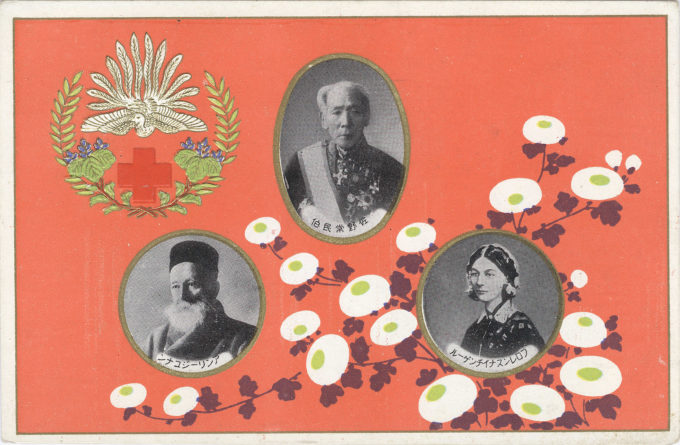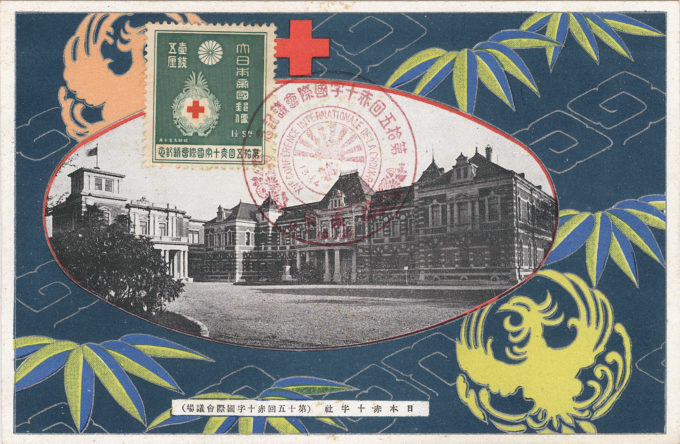“The Fifteenth International Red Cross Conference opened yesterday, in Tokyo with 63 countries represented with over 300 official delegates participating. Her Imperial Highness Empress Nagako read the welcome address lo 58 representatives of foreign countries, who had arrived earlier for the International parley which will continue from Oct. 17-29.
“Red Cross Day”, Fifteenth Quadrennial International Red Cross Conference commemorative postcard, Tokyo, 1934. A postcard reproduction of the winning entry to a poster contest celebrating the conference.
“The significant conference with a cosmopolitan gathering is being held in the Orient for the first time in its history. Outside of foreign representatives, some 400 delegates from provincial branches of the Japanese Red Cross Society will attend the affair.
“Foreign delegates represent either their governments or their respective Red Cross Societies. Many prominent men of distinction and renown are listed on the program to make the conference a valuable impetus to the future development of international cooperation in Red Cross work.
“… The International Red Cross Conference is a significant event, as it is the supreme machinery for passing resolutions concerning International Red Cross activities. The conference is held every four years and participated in by countries signatory to the Geneva Treaty. Although its resolutions do not bind the governments, its semi-government character makes the resolutions passed set a standard for international treaties to follow.”
– “International Red Cross Meet in Japan for Conference”, The New World Daily News, San Francisco, October 19, 1934

Fifteenth Quadrennial International Red Cross Conference, Tokyo, October 17-29, 1934. Clockwise from top: Count Sano Tsunetami (founder, Japan Red Cross), Florence Nightengale (founder, British Red Cross), Henri Dunant (co-founder, International Committee of the Red Cross; first Nobel Peace Prize laureate). The International Red Cross Conference, attended by representatives of the national and international Red Cross institutions and governments, is the supreme legislative authority of the Red Cross. The Conference is convened, in principle, every four years. Tokyo played host in 1934, following that of Brussels in 1930 and preceding that of London in 1938 (the last, until the end of World War II).
The idea for the ‘Red Cross Truce’ was first proposed in 1934 at the Tokyo conference. However, it was not until 1946, after World War II came to an end, that the League of Red Cross Societies (LRCS) was able to begin giving the proposal serious consideration. Following its passage in 1948, the first Red Cross Day was observed and is now celebrated annually.
See also:
15th International Conference of the Red Cross commemorative postcard and stamps, Tokyo, 1934.
Japan Red Cross Society commemorative postcard, c. 1937.
Ward in the Japanese Red Cross Central Hospital, Tokyo, c. 1910.
“Until World War I, the law of war was based on the assumption that civilians enjoyed complete immunity from war operations. No provisions with respect to civilians existed except those on their treatment in occupied territory, contained in the Hague Regulations of 1899 and 1907.
“World War I fundamentally altered the situation. Enemy civilians in the territories of belligerents were interned in great numbers notwithstanding the lack of relevant provisions. Moreover, the provisions of the Hague Regulations on the occupied territories proved to be insufficient in view of changed circumstances.
“After the war, the International Conference of the Red Cross prepared drafts for a convention on the protection of civilians in the territory of belligerents and in occupied territories … Some governments feared that a new convention relating to war would undermine the cause of peace. As a consequence, no draft on civilians was submitted to the Diplomatic Conference of 1929.
“… The ICRC prepared a draft that was approved at the XVth Quadrennial International Red Cross Conference in Tokyo in 1934, with a view to its submission to a diplomatic conference convened by the Swiss government. Due to the slowness of government reactions, the date of the conference could not be set until 1939. It was fixed for the beginning of 1940. The outbreak of war in September 1939 prevented its taking place [until 1948].”
– Introduction to “Draft International Convention on the Condition and Protection of Civilians of Enemy Nationality Who Are on Territory Belonging To or Occupied By A Belligerent”, edited by Jiri Toman & Dietrich Schindler, The Laws of Armed Conflicts: A Collection of Conventions, Resolutions and Other Documents, 1973




Pingback: HIH Princess Kan-in, President of the Volunteer Nurses Association, 1910. | Old TokyoOld Tokyo